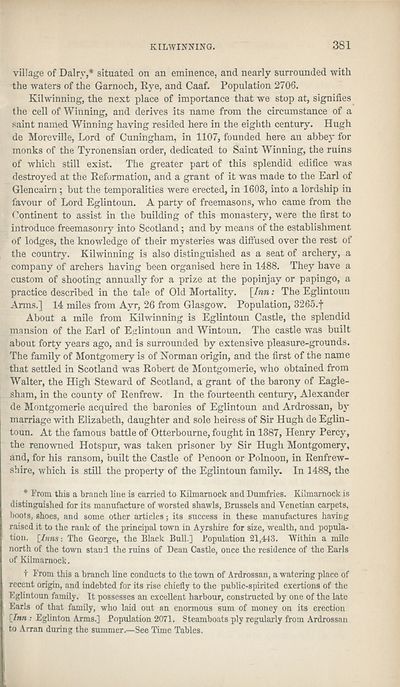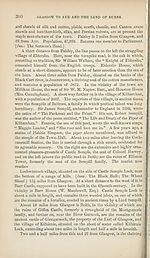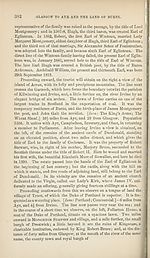Download files
Complete book:
Individual page:
Thumbnail gallery: Grid view | List view

KILWINNING.
village of Dairy,* situated on an eminence, and nearly surrounded with
the waters of the Gamoch, Eye, and Caaf. Population 2706.
Kilwinning, the next place of importance that we stop at, signifies
the cell of Winning, and derives its name from the circumstance of a
saint named Winning having resided here in the eighth century. Hugh
de Moreville, Lord of Cuningham, in 1107, founded here an abbey for
monks of the Tyronensian order, dedicated to Saint Winning, the ruins
of which still exist. The greater part of this splendid edifice was
destroyed at the Reformation, and a grant of it was made to the Earl of
Glencairn; but the temporalities were erected, in 1603, into a lordship in
favour of Lord Eglintoun. A party of freemasons, who came from the
Continent to assist in the building of this monastery, were the first to
introduce freemasonry into Scotland; and by means of the establishment
of lodges, the knowledge of their mysteries was diffused over the rest of
the country. Kilwinning is also distinguished as a seat of archery, a
company of archers having been organised here in 1488. They have a
custom of shooting annually for a prize at the popinjay or papingo, a
practice described in the tale of Old Mortality. [Inn: The Eglintoun
Arms.] 14 miles from Ayr, 26 from Glasgow. Population, 3265.f
About a mile from Kilwinning is Eglintoun Castle, the splendid
mansion of the Earl of Eglintoun and Wintoun. The castle was built
about forty years ago, and is surrounded by extensive pleasure-grounds.
The family of Montgomery is of Norman origin, and the first of the name
that settled in Scotland was Robert de Montgomerie, who obtained from
Walter, the High Steward of Scotland, a grant of the barony of Eagle-
sham, in the county of Renfrew. In the fourteenth century, Alexander
de Montgomerie acquired the baronies of Eglintoun and Ardrossan, by
marriage with Elizabeth, daughter and sole heiress of Sir Hugh de Eglin¬
toun. At the famous battle of Otterbourne, fought in 1387, Henry Percy,
the renowned Hotspur, was taken prisoner by Sir Hugh Montgomery,
and, for his ransom, built the Castle of Penoon or Polnoon, in Renfrew¬
shire, which is still the property of the Eglintoun family. In 1488, the
* From this a branch line is carried to Kilmarnock and Dumfries. Kilmarnock is
distinguished for its manufacture of worsted shawls, Brussels and Venetian carpets,
hoots, shoes, and some other articles; its success in these manufactures having
raised it to the rank of the principal town in Ayrshire for size, wealth, and popula¬
tion. linns-. The George, the Black Bull] Population 21,443. 'Within a mile
north of the town stand the ruins of Dean Castle, once the residence of the Earls
of Kilmarnock.
t From this a branch line conducts to the town of Ardrossan, a watering place of
recent origin, and indebted for its rise chiefly to the public-spirited exertions of the
Eglintoun family. It possesses an excellent harbour, constructed by one of the late
Earls of that family, who laid out an enormous sum of money on its erection
[Inn: Eglinton Arms.] Population 2071. Steamboats ply regularly from Ardrossan
to Arran during the summer.—See Time Tables.
village of Dairy,* situated on an eminence, and nearly surrounded with
the waters of the Gamoch, Eye, and Caaf. Population 2706.
Kilwinning, the next place of importance that we stop at, signifies
the cell of Winning, and derives its name from the circumstance of a
saint named Winning having resided here in the eighth century. Hugh
de Moreville, Lord of Cuningham, in 1107, founded here an abbey for
monks of the Tyronensian order, dedicated to Saint Winning, the ruins
of which still exist. The greater part of this splendid edifice was
destroyed at the Reformation, and a grant of it was made to the Earl of
Glencairn; but the temporalities were erected, in 1603, into a lordship in
favour of Lord Eglintoun. A party of freemasons, who came from the
Continent to assist in the building of this monastery, were the first to
introduce freemasonry into Scotland; and by means of the establishment
of lodges, the knowledge of their mysteries was diffused over the rest of
the country. Kilwinning is also distinguished as a seat of archery, a
company of archers having been organised here in 1488. They have a
custom of shooting annually for a prize at the popinjay or papingo, a
practice described in the tale of Old Mortality. [Inn: The Eglintoun
Arms.] 14 miles from Ayr, 26 from Glasgow. Population, 3265.f
About a mile from Kilwinning is Eglintoun Castle, the splendid
mansion of the Earl of Eglintoun and Wintoun. The castle was built
about forty years ago, and is surrounded by extensive pleasure-grounds.
The family of Montgomery is of Norman origin, and the first of the name
that settled in Scotland was Robert de Montgomerie, who obtained from
Walter, the High Steward of Scotland, a grant of the barony of Eagle-
sham, in the county of Renfrew. In the fourteenth century, Alexander
de Montgomerie acquired the baronies of Eglintoun and Ardrossan, by
marriage with Elizabeth, daughter and sole heiress of Sir Hugh de Eglin¬
toun. At the famous battle of Otterbourne, fought in 1387, Henry Percy,
the renowned Hotspur, was taken prisoner by Sir Hugh Montgomery,
and, for his ransom, built the Castle of Penoon or Polnoon, in Renfrew¬
shire, which is still the property of the Eglintoun family. In 1488, the
* From this a branch line is carried to Kilmarnock and Dumfries. Kilmarnock is
distinguished for its manufacture of worsted shawls, Brussels and Venetian carpets,
hoots, shoes, and some other articles; its success in these manufactures having
raised it to the rank of the principal town in Ayrshire for size, wealth, and popula¬
tion. linns-. The George, the Black Bull] Population 21,443. 'Within a mile
north of the town stand the ruins of Dean Castle, once the residence of the Earls
of Kilmarnock.
t From this a branch line conducts to the town of Ardrossan, a watering place of
recent origin, and indebted for its rise chiefly to the public-spirited exertions of the
Eglintoun family. It possesses an excellent harbour, constructed by one of the late
Earls of that family, who laid out an enormous sum of money on its erection
[Inn: Eglinton Arms.] Population 2071. Steamboats ply regularly from Ardrossan
to Arran during the summer.—See Time Tables.
Set display mode to:
![]() Universal Viewer |
Universal Viewer | ![]() Mirador |
Large image | Transcription
Mirador |
Large image | Transcription
| Antiquarian books of Scotland > Scotland/Scots > Black's picturesque tourist of Scotland > (495) |
|---|
| Permanent URL | https://digital.nls.uk/130034130 |
|---|
| Description | Thousands of printed books from the Antiquarian Books of Scotland collection which dates from 1641 to the 1980s. The collection consists of 14,800 books which were published in Scotland or have a Scottish connection, e.g. through the author, printer or owner. Subjects covered include sport, education, diseases, adventure, occupations, Jacobites, politics and religion. Among the 29 languages represented are English, Gaelic, Italian, French, Russian and Swedish. |
|---|

